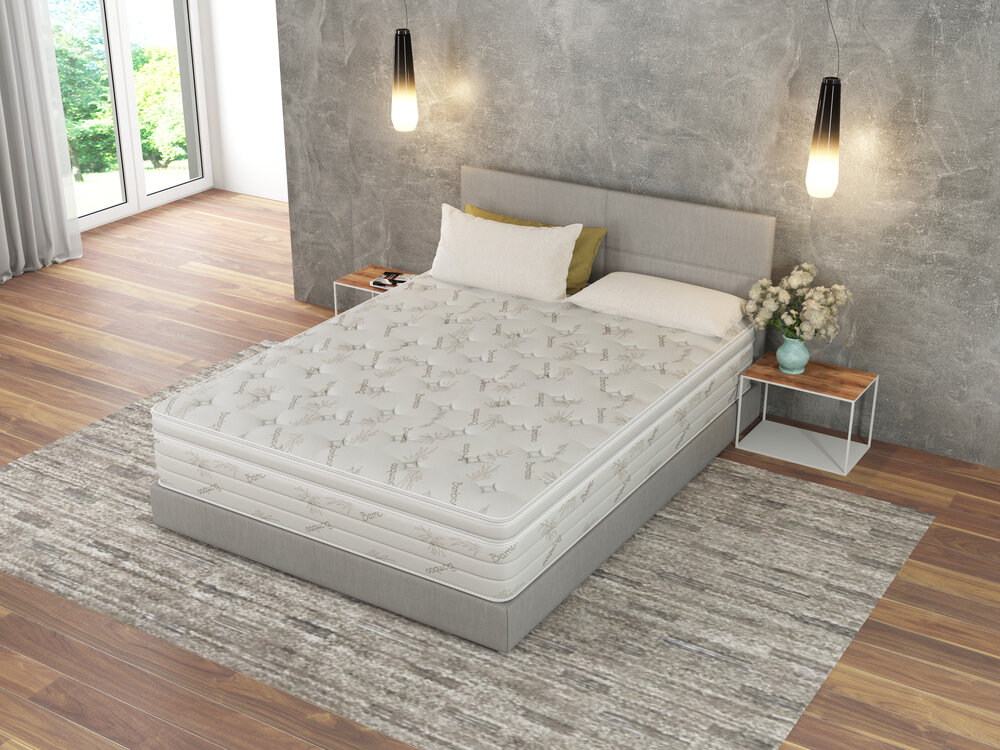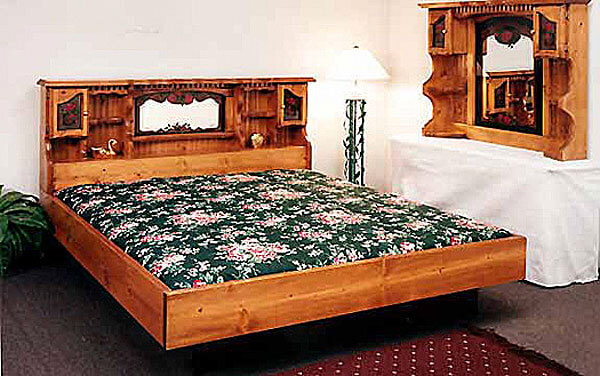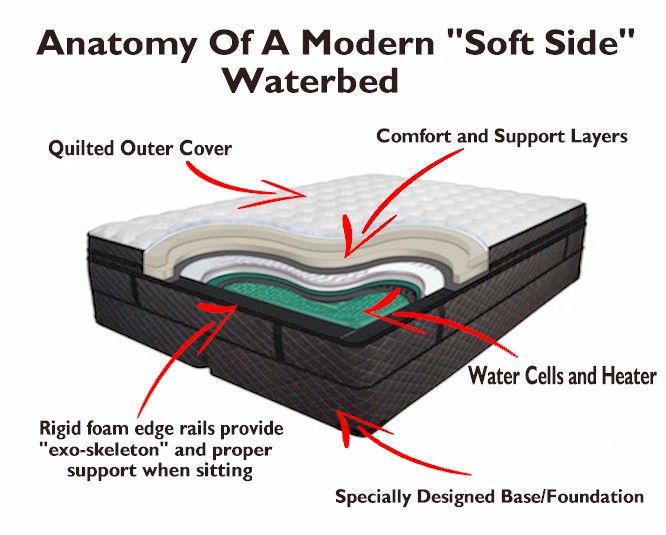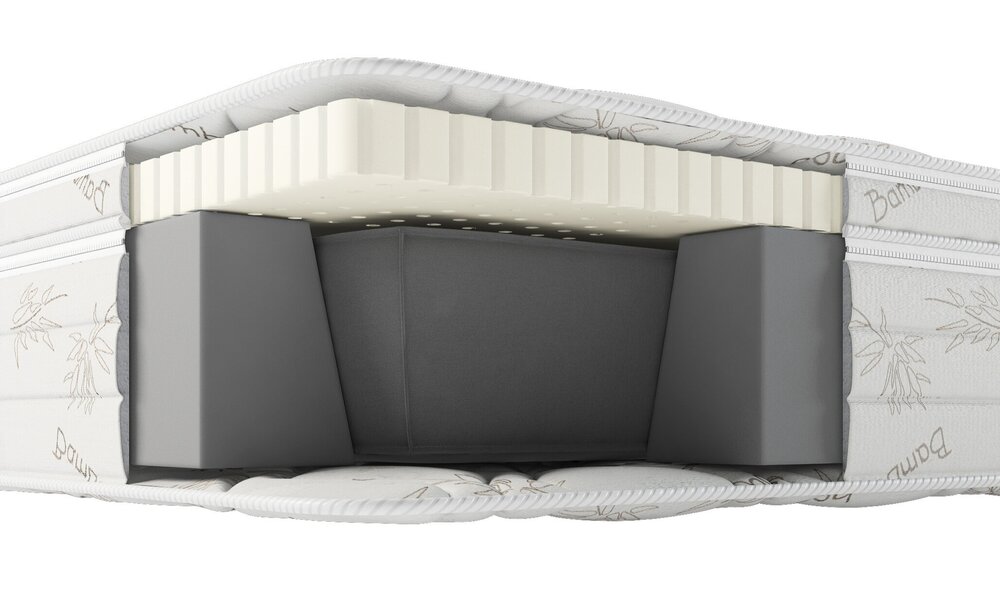Softside Waterbed Mattress Reviews: Find the Best Waterbed for You!
Waterbeds broke all the rules. During the industry’s 20 year heyday, waterbeds became the iconic sleep surface that were designed to be a clear alternative to the traditional innerspring beds that had been sold in mattress stores literally for generations. They were comfortable, supportive, cradling, and excellent for spine issues and those with sleep disorders and muscle soreness. And, the water bed was the counter-culture’s mattress of choice.
In fact, the sleepy and dreary bedding industry didn’t have anything new to offer in the 70’s and boring conventional mattresses came in two varieties: torture rack firm and ridiculously firm. In their time, the most popular mattress to own was a waterbed, now referred to as a “watermattress”. It was a vinyl chamber you filled with cool, clear water. But what is it about waterbeds that made them so incredible, so amazing, that people flocked to waterbed stores to buy them?
It’s actually pretty simple. Water cradles and supports the body evenly due to the natural laws of hydraulics, pushing back with equal force to the force of the person’s body when lying down. Sleeping on a waterbed leaves you delightfully free of pressure points — you only experience conforming, enveloping support, along with a levitating like sensation.
A water bed offers buoyant, flotation like comfort that is calming, great for back pain, soothing, and nest-like. A typical bed in a box mattress isn’t often described that way, and in many cases, doesn’t deliver on comfort or support, with many consumers who ultimately move to a water bed describing the typical foam mattress as “hard, indented, mashed, and a hot mess”, according to one of our readers.
The fact is, a typical foam or coil and foam hybrid mattress has to fight gravity, with your weight pushing down, crushing everything beneath it. It’s only a mattress of time before the product warranty or trial period catches up with you and you’re stuck with a flat and mashed husk of a mattress. A water bed won’t mash down, compress, flatten, or make you feel trapped inside.
Technology has turned water beds into a state of the art sleep surface
Today’s watermattress relies on some critical advances on improving the original technology. For one, today’s watermattress is motionless, and does not swish and sway like the original designs. This is achieved by using specialized Dacron inserts which are placed inside of the vinyl water “chambers” which minimize motion transfer. You still get the flotation feel and the levitating, pressure relieving benefits of sleeping on water, without the waves.
Many advanced models, including the model we recommend, also contain additional comfort layers such as memory foam and latex which enhances the pressure relieving experience even further. The watermattress we recommend, The Mirage WaterMattress by Habitat Furnishings, actually contains a layer of natural latex which provides additional support, pressure relief, and comfort, further amplifying the benefit of true flotation sleep.

If you are shopping for a new mattress, and you’re stuck on the “bed in a box” option when shopping online, remember that almost all of them are going to have an identical feel. There’s only so much you can do when you are stacking foam layers and essentially moving the layers around on what mattress engineers call the “cake recipe”. The limited number of materials, usually just memory foam, latex, springs, and dense polyurethane foams proved only a limited range of comfort, support, and pain relief. The reality is, there is no bed in a box option that feels really buoyant, without that sinking sensation..
The Mirage WaterMattress, though, does ship directly to your door, and the price includes free shipping. They ship using FedEx freight, and have been doing that for years with their other products which include a line of sleep number style air bed systems, built in a surprisingly similar way, using air chambers instead of water filled chambers.
Back in the day when water beds were first taking off, a waterbed could be bought for a few hundred bucks, something that a young person with barely two nickels to rub together could buy, and something even a middle aged couple would think was totally awesome. Ah, sleeping on pure water. Natural, healing, soothing. Womb-like.
Waterbed store owners honestly felt like they were saving consumers from some hard-as-a-rock torture rack known as the innerspring mattress, just like the bed in a box web sites are trying to do today, though it’s more about saving you from the nightmare of shopping in a giant retail cavern, lit up by glaring fluorescent lights, and equipped with a hovering sales guy who flutters over you while you try to choose the most intimate product in your life, next to your underwear.

So if waterbeds were so wonderful, what happened to them?
Over the industry’s 20-year run of unbridled popularity, from around 1970-1990, consumers purchased between 25 and 30 million waterbeds. This surge in sales did not go unnoticed by the coil mattress industry. While some of the “spring bed” manufacturers did add some waterbed-type beds to their lines, most did not. Instead, unlike the waterbed people, largely resistant to change, the coil mattress makers were smart. They dumbed down the waterbed and brought the species to the edge of extinction.
Under the increased pressure of the mainstream coil mattress mob and their plusher, “synthetic waterbeds”, real waterbed retailers tried desperately to compete. As the waterbed epoch began to feel the rumblings of an incoming asteroid, you could buy one just about anywhere for $99- for any sized bed. Everybody wanted a bed that was inviting, softer, enveloping, and nest-like, and the special niche was in for a nuclear winter of unbelievable magnitude.
Interestingly, coil mattress conglomerates, seeing the success of plush, conforming sleep surfaces, started making plush, even pillow top and Euro top mattresses, offering them to consumers for the unheard of prices of $1000 and more. All this at a time when those “firm,” thin mattresses (you know, the original types of mattresses) were selling from $200 to $400.
And thus the popularity of waterbeds waned, slumped, and slid out of the industry. But their influence can still be felt in the mattress industry today — literally. Today, if you go shopping for a mattress, you can hardly find a truly firm model – everything is plush and thick. Even the “firm” mattresses are cushion firm or plush firm. We’re now in the era of the big, thick, fluffy mattress — at least if you’re shopping the mainstream lines.
So while it may be true that waterbeds are dead and gone, the legacy of the waterbed era is evident in the choices you find in mattress stores today. And for those customers who love their waterbed more than anything and refuse to give it up, you can still find lumbering sites that carry on the tradition, selling “hard side” and now the more popular and relevant “soft side” waterbeds, and parts and pieces, too.
In 1968 Charles Hall presented the waterbed as his Master’s Thesis project to his San Francisco State University design class. While showcasing their work, students rotated through workshops to see each others inventions. Once they reached Hall’s project – a vinyl mattress filled with heated water – the class never left. “Everybody just ended up frolicking on the waterbed,” Hall recalls. For the next twenty years, waterbeds were hot. I mean surface of the sun hot. They were The Bed of the Sexual Revolution.
Hugh Hefner reportedly had a king size circular water bed, covered in Tasmanian possum hair. That’s right, possum hair.b Companies used that sex appeal to their advantage with slogans like, “Two things are better on a waterbed. One of them is sleep.” and “She’ll admire you for your car, she’ll respect you for your position, but she’ll love you for your waterbed.” It worked.
“In Manhattan, the waterbed display at Bloomingdale’s department store for a while was a popular singles meeting place. Sears, Roebuck and Holiday Inns are eying the beds, and Lake Tahoe’s Kings Castle Hotel has already installed them in its luxury suites,” Time Magazine wrote in 1971. “Playboy Tycoon Hugh Hefner has one–king-size, of course, and covered with Tasmanian opossum [sic].
The growing number of manufacturers and distributors, with such appropriate names as Aquarius Products, the Water Works, Innerspace Environments, Joyapeutic Aqua Beds and the Wet Dream, can hardly meet the demand. They have sold more than 15,000 since August.”
By 1986, they had 20 percent of the bed market. Everyone wanted one. And then, as suddenly as they’d become cool, they became lame. Super lame. Like, handle bar mustache and shoulder pad lame. But, maybe it is time that waterbeds made a comeback. Hall points out that he never intended for his invention to be so deeply associated with the disco ball and bell bottom wearing ’70s. He had a much grander vision.
He wanted to change the way people thought about and used bedding and sleep surfaces. At the time, Hall thought too much mattress design focused on style, and he wanted to shift the emphasis to comfort and support. He began by creating mattresses using various materials that would eliminate pressure points and use heat to relax muscles (but this was long before materials like “memory foam” were even thought about).
Hall’s first crack at a product, a vinyl bag filled with 300 pounds of liquid corn-starch, failed. It was great at reducing pressure points, but engulfed anyone who sat in it. Next, Hall thought a gelatinous material like Jell-o might solve the problem, but it still wasn’t the right temperature or consistency (Nostradamus like, he was already creating in his mind both “memory foam” and “gel foam”.
So he moved on, working on the object we spend the most time in. At the age of 24, Hall designed the modern waterbed: a vinyl water-filled bladder equipped with a temperature control device meant to synchronize with human body temperature. “I designed a serious sleep product,” he says. It’s not hard to believe Hall. In the late 1960s, the design department at SFU was a hotbed of alternative technology. It was known for what historian Andrew Kirk modestly called a “free-form atmosphere.”
For example, in ’67, famed designer J. Baldwin was there “rebuilding a giant camera from a U-2 spy plane he had purchased at a military surplus sale for thirty dollars.” (One day, countercultural icon Stewart Brand showed up in a toga and a top hat to befriend Baldwin. The pair worked on a series of publications together, including the National Book Award Winning Whole Earth Catalog.) San Francisco State was a good place to be doing weird stuff with the things of modern life.
But perhaps it was inevitable that his work would be taken up by people intent on doing more in bed than sleeping. Hall’s design was completed in the year of the “summer of love,” after all. Hall wasn’t the first to think about how nice it might be to sleep on heated water. In the early 1800s, to relieve patient bedsores, Dr. Neil Arnot created a ‘hydrostatic bed’ by covering a warm bath with India-rubber cloth and then sealing it with varnish to prevent leaks.
In 1893 a British physician, Dr. Portsmouth, patented a similar invention. These early incarnations couldn’t really contain heat or water, so they never garnered commercial success. Then, in the early 20th century, Robert Heinlein’s science fiction novels prophesied the modern waterbed, but he never actually built the bed.
“I designed the waterbed during years as a bed patient in the middle thirties; a pump to control water level, side supports to permit one to float rather than simply lying on a not very soft water filled mattress. Thermostatic control of temperature, safety interfaces to avoid all possibility of electric shock, waterproof box to make a leak no more important than a leaky hot water bottle rather than a domestic disaster, calculation of floor loads (important!), internal rubber mattress and lighting, reading, and eating arrangements–an attempt to design the perfect hospital bed by one who had spent too damn much time in hospital beds.” The science fiction icon was spot on about the mattress of the future.
Regardless of Heinlein’s dreams, it wasn’t until vinyl became widely used that a marketable waterbed was possible. Discovered in the 1800s, the plastic’s first commercial uses didn’t come along until the 1930s, when it was used to make shock absorber seals and synthetic tires. These successes, combined with the rubber shortage during World War II, led to further development. By 1968 vinyl’s capabilities had expanded and diversified, providing Hall with a durable fabric for his bed.
With the right materials and design, people could finally realize the dream of sleeping on water! Hall figured he had a success on his hands, a product that would revolutionize sleep. But would people toss their Serta’s and Simmon’s and Sealy’s for the bed that promised undisturbed sleep? “No. Absolutely not,” sighs Hall, “They bought it for the sensual or the sexual part of it.”
That sexual association, great marketing during the 1970s and early 1980s, became an albatross by the early 1990s. “It’s no longer the new thing, so it doesn’t have the traction that it once had ,” explains Henry Petroski, an engineering professor at Duke University who focuses on product design. Not only was it the cool new gadget, but it emerged during a time when the culture embraced anything different, especially a product that embodied sexual liberation. It only worked in that context, Petroski says. When the spirit of the times changed, what had been James Bond became Austin Powers.
But the waterbed also had technological shortcomings. Waterbeds can spring leaks. They are heavy. The extra parts require maintenance. Moving one requires draining the bed – too much of a hassle for most people. Even Hall admits that the bed was complicated and high maintenance. As the market grew, vinyl material became more sophisticated and refined, more stable. The older hard side “free flow” mattresses generated significant wave action, requiring stabilization time after any disturbance.
But, the newer waveless waterbeds, combine air and water pockets, reducing this sensation while maintaining the bed’s benefits. They also look more like “normal” beds, and less like Pleasure Pits. You can put what is called a “softside” waterbed on virtually any surface, so long as it can take the weight of water, though even the water cells, or chambers, slowly began to be reduced in size as comfort layers were added up top. Enough water is left in the entire recipe to deliver the wonderfully buoyant and levitating elements that it was required to deliver.
But by the time the waterbed world caught on to the hybridized version of the bed, and a truly amazing formula had finally been worked out, the timing, well, you now about timing. Once the waterbed had shown that people were open to innovation in the bedroom, other less complicated beds, such as the Tempur-Pedic mattress, entered the market. These designs emulated the comfort of the bed without the hassle of the water.

Unfortunately, folks still associate waterbeds with their high maintenance past. “Even if there aren’t actual problems, people can imagine that there are problems that would do some damage,” remarks Petroski. By 1990ish, Michael Spintman, a salesman at the Washington DC store Showman Furniture, is forced to trick his customers into buying waterbeds. Spintman shows the beds, but dares not muse the term “waterbed”.
And even if customers are happy with the mattress’s feel, once they discover it’s a waterbed, they won’t buy it. “Everybody who tries the ones we have on our floor is very happy with the feel, but some people won’t get it just because it’s a waterbed,” explains Spintman, who not only owns a waterbed, but thinks it offers the best sleep out there.
On and on it went like this. the stigma. Waterbed market share in the mattress business drops and drops. Now, it hovers at something less than 5 percent, a technology that’s seen better days. But you have to wonder, whatever the waterbed’s actual merits, what’s it say about this country that in the American bed industry, sex no longer sells?
The New Waterbed “wave”…poised to make a comeback
Waterbed manufacturers and showrooms are still easy enough to find, if you’re looking. Beds and mattresses by InnoMax, Boyd Specialty Sleep, Strobel, United States Watermattress, American National and others vie for pecking order in the market. A few online retailers are on top of the game with forward thinking models.
Most offer hard-sided beds that, like the original clunky versions, rely on a major piece of wood furniture to hold the mattress in place. But newer, soft-sided water mattresses can stand on their own, though they all need some kind of a solid base because of the weight of the mattress. Depending on size, a water mattress can hold up to 200 gallons (757 liters), or more than 1,600 pounds (725 kilograms) of H2O.
The mystique and lure of waterbeds always has been the water. Even the most highly schooled mattress and sleep experts swear by its all-around supportive properties. There is no gimmick. It’s purely about being “enveloped” in water, rather than laying on top of coils and stiff foam with nothing aquatic underneath. The technology is far ahead of where it was in the 70’s. Most water mattresses now come with baffles, too, that control how “waveless” they are, for those turned off by that too-sloshy feeling.
Most have heaters that can regulate the temperature of the water anywhere from 70 to 100 degrees Fahrenheit (21 to 38 degrees Celsius). Comfort layers above the water cells like memory foam, natural latex, gel foam, graphite infused foam, and other materials embellish and add to the experience.
Even better, the newest water mattresses are split into dual zones, too, so one person can enjoy a different firmness, temperature and wave-control than his or her sleeping partner. The waterbed of the 21st century, clearly, is not the fur-covered playground that Hugh Hefner put on his private jet and flew around on in the ’70s.
“I still think the waterbed is the best bed that’s ever been invented. Period. And there are a lot of people out there that feel that way,” the inventor of the water mattress says. The innovations, Hall is hoping, will spur nostalgia in some and interest a new generation of buyers in a piece of bedroom furniture that they may know little about.
“I think that some people will have a memory of it and want to revisit it just because they remember waterbeds and want to see how different they are,” Hall told the Sun. “And then there’ll be a generation, it’ll be a total novelty for them. We are coming for the millenials and beyond”.
Capturing the new generation of buyers may be the biggest challenge in the waterbed’s comeback. Occasionally, water bed retailers are beginning to see young people nosing around stores, trying to find an alternative to the sensory overload of bed in a box foam mattresses that all run together in a blur.
Sometimes, they’re accompanied by parents or grandparents who drag the kids along to show them a relic from the past. “It’s like a novelty item. They’ve never seen one before,” he says. “It blows my mind that they haven’t seen a waterbed.”
This would all seem rather quaint if sleep weren’t such a deadly serious topic. Research over the past few years has shown just how critical a good night’s sleep is. A continued lack of sufficient sleep has been strongly associated with, among other health problems, obesity, diabetes, heart disease, hypertension and a decreased life expectancy.
Water mattress gurus see a potential answer to that problem already existing in the bedding industry consciousness, just as it has been for the past 43 years, ready to be reawakened. “There’s just something about that semi-weightless state that you can only get laying on a waterbed,” he says. “There’s something about it that’s so soothing and relaxing.”
WHO WE RECOMMEND AS OUR TRUSTED DEALER FOR AN OUTSTANDING WATER BED
For years our CEO and editor designed and invented air beds. We partnered up with a company in Baltimore, Maryland that specialized in flotation bedding and had been building a wonderful line of water beds for thirty years. The company is called Habitat Furnishings, and although they have been building waterbeds for over 35 years, and build all of their products in Baltimore, Maryland, they have revolutionized waterbed engineering and design with their latest model, The Mirage®.
Pioneers in both “soft side” and the old school wooden framed “hard side” water beds, The Mirage, form all outward appearances, looks just like any other high end luxury mattress. Inside however, is a state of the art waterbed designed to deliver a completely different sleep experience than you‘ve ever tried before.

Habitat Furnishings has combined the pressure relieving and sleep conductive qualities of pure latex and water to bring the Mirage WaterMattress to consumers who are exhausted from trying endless hard and uncomfortable foam beds. Check out their web site here.